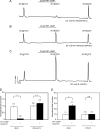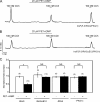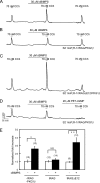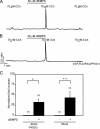InsP3R-associated cGMP kinase substrate determines inositol 1,4,5-trisphosphate receptor susceptibility to phosphoregulation by cyclic nucleotide-dependent kinases
- PMID: 20876535
- PMCID: PMC2988395
- DOI: 10.1074/jbc.M110.168989
InsP3R-associated cGMP kinase substrate determines inositol 1,4,5-trisphosphate receptor susceptibility to phosphoregulation by cyclic nucleotide-dependent kinases
Abstract
Ca(2+) release through inositol 1,4,5-trisphosphate receptors (InsP(3)R) can be modulated by numerous factors, including input from other signal transduction cascades. These events shape the spatio-temporal characteristics of the Ca(2+) signal and provide fidelity essential for the appropriate activation of effectors. In this study, we investigate the regulation of Ca(2+) release via InsP(3)R following activation of cyclic nucleotide-dependent kinases in the presence and absence of expression of a binding partner InsP(3)R-associated cGMP kinase substrate (IRAG). cGMP-dependent kinase (PKG) phosphorylation of only the S2+ InsP(3)R-1 subtype resulted in enhanced Ca(2+) release in the absence of IRAG expression. In contrast, IRAG bound to each InsP(3)R subtype, and phosphorylation of IRAG by PKG attenuated Ca(2+) release through all InsP(3)R subtypes. Surprisingly, simply the expression of IRAG attenuated phosphorylation and inhibited the enhanced Ca(2+) release through InsP(3)R-1 following cAMP-dependent protein kinase (PKA) activation. In contrast, IRAG expression did not influence the PKA-enhanced activity of the InsP(3)R-2. Phosphorylation of IRAG resulted in reduced Ca(2+) release through all InsP(3)R subtypes during concurrent activation of PKA and PKG, indicating that IRAG modulation is dominant under these conditions. These studies yield mechanistic insight into how cells with various complements of proteins integrate and prioritize signals from ubiquitous signaling pathways.
Figures









Similar articles
-
Molecular determinants of the interaction between the inositol 1,4,5-trisphosphate receptor-associated cGMP kinase substrate (IRAG) and cGMP kinase Ibeta.J Biol Chem. 2001 Jun 29;276(26):24153-9. doi: 10.1074/jbc.M101530200. Epub 2001 Apr 17. J Biol Chem. 2001. PMID: 11309393
-
Phosphorylation of type-1 inositol 1,4,5-trisphosphate receptors by cyclic nucleotide-dependent protein kinases: a mutational analysis of the functionally important sites in the S2+ and S2- splice variants.J Biol Chem. 2003 Nov 14;278(46):45811-7. doi: 10.1074/jbc.M306270200. Epub 2003 Aug 25. J Biol Chem. 2003. PMID: 12939273
-
Functional consequences of phosphomimetic mutations at key cAMP-dependent protein kinase phosphorylation sites in the type 1 inositol 1,4,5-trisphosphate receptor.J Biol Chem. 2004 Oct 29;279(44):46242-52. doi: 10.1074/jbc.M405849200. Epub 2004 Aug 11. J Biol Chem. 2004. PMID: 15308649
-
IRAG and novel PKG targeting in the cardiovascular system.Am J Physiol Heart Circ Physiol. 2011 Sep;301(3):H672-82. doi: 10.1152/ajpheart.00198.2011. Epub 2011 Jun 10. Am J Physiol Heart Circ Physiol. 2011. PMID: 21666108 Review.
-
Modulation of Ca2+ oscillations by phosphorylation of Ins(1,4,5)P3 receptors.Biochem Soc Trans. 2003 Oct;31(Pt 5):954-7. doi: 10.1042/bst0310954. Biochem Soc Trans. 2003. PMID: 14505457 Review.
Cited by
-
Activation of cyclic GMP-dependent protein kinase blocks alcohol-mediated cell death and calcium disruption in cerebellar granule neurons.Neurosci Lett. 2018 May 29;676:108-112. doi: 10.1016/j.neulet.2018.04.026. Epub 2018 Apr 19. Neurosci Lett. 2018. PMID: 29679679 Free PMC article.
-
Regulation of IP3 receptors by cyclic AMP.Cell Calcium. 2017 May;63:48-52. doi: 10.1016/j.ceca.2016.10.005. Epub 2016 Nov 6. Cell Calcium. 2017. PMID: 27836216 Free PMC article. Review.
-
Prostaglandin E2 Inhibits Histamine-Evoked Ca2+ Release in Human Aortic Smooth Muscle Cells through Hyperactive cAMP Signaling Junctions and Protein Kinase A.Mol Pharmacol. 2017 Nov;92(5):533-545. doi: 10.1124/mol.117.109249. Epub 2017 Sep 6. Mol Pharmacol. 2017. PMID: 28877931 Free PMC article.
-
Jaw1/LRMP increases Ca2+ influx upon GPCR stimulation with heterogeneous effect on the activity of each ITPR subtype.Sci Rep. 2022 Jun 8;12(1):9476. doi: 10.1038/s41598-022-13620-4. Sci Rep. 2022. PMID: 35676525 Free PMC article.
-
Novel Functional Features of cGMP Substrate Proteins IRAG1 and IRAG2.Int J Mol Sci. 2023 Jun 7;24(12):9837. doi: 10.3390/ijms24129837. Int J Mol Sci. 2023. PMID: 37372987 Free PMC article. Review.
References
-
- Berridge M. J., Bootman M. D., Roderick H. L. (2003) Nat. Rev. Mol. Cell Biol. 4, 517–529 - PubMed
-
- Patterson R. L., Boehning D., Snyder S. H. (2004) Annu. Rev. Biochem. 73, 437–465 - PubMed
-
- Conti M., Beavo J. (2007) Annu. Rev. Biochem. 76, 481–511 - PubMed
-
- Willoughby D., Cooper D. M. (2007) Physiol. Rev. 87, 965–1010 - PubMed
-
- Berridge M. J., Lipp P., Bootman M. D. (2000) Nat. Rev. Mol. Cell Biol. 1, 11–21 - PubMed
Publication types
MeSH terms
Substances
Grants and funding
LinkOut - more resources
Full Text Sources
Miscellaneous

